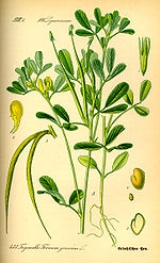
Fenugreek
Overview
Fenugreek is a plant in the family Fabaceae
. Fenugreek is used both as a herb
(the leaves) and as a spice
(the seed
, often called methi in Urdu/Hindi). The leaves and sprouts are also eaten as vegetables. The plant is cultivated worldwide as a semi-arid crop and is a common ingredient in many curries
.
The name fenugreek or foenum-graecum is from Latin for "Greek hay". The plant's similarity to wild clover has likely spawned its Swedish name: "bockhornsklöver" as well as the German: "Bockshornklee", both literally meaning: "ram's horn clover".
Zohary and Hopf note that it is not yet certain which wild strain of the genus Trigonella gave rise to the domesticated fenugreek but believe it was brought into cultivation in the Near East
.
Fabaceae
The Fabaceae or Leguminosae, commonly known as the legume, pea, or bean family, is a large and economically important family of flowering plants. The group is the third largest land plant family, behind only the Orchidaceae and Asteraceae, with 730 genera and over 19,400 species...
. Fenugreek is used both as a herb
Herb
Except in botanical usage, an herb is "any plant with leaves, seeds, or flowers used for flavoring, food, medicine, or perfume" or "a part of such a plant as used in cooking"...
(the leaves) and as a spice
Spice
A spice is a dried seed, fruit, root, bark, or vegetative substance used in nutritionally insignificant quantities as a food additive for flavor, color, or as a preservative that kills harmful bacteria or prevents their growth. It may be used to flavour a dish or to hide other flavours...
(the seed
Seed
A seed is a small embryonic plant enclosed in a covering called the seed coat, usually with some stored food. It is the product of the ripened ovule of gymnosperm and angiosperm plants which occurs after fertilization and some growth within the mother plant...
, often called methi in Urdu/Hindi). The leaves and sprouts are also eaten as vegetables. The plant is cultivated worldwide as a semi-arid crop and is a common ingredient in many curries
Curry
Curry is a generic description used throughout Western culture to describe a variety of dishes from Indian, Pakistani, Bangladeshi, Sri Lankan, Thai or other Southeast Asian cuisines...
.
The name fenugreek or foenum-graecum is from Latin for "Greek hay". The plant's similarity to wild clover has likely spawned its Swedish name: "bockhornsklöver" as well as the German: "Bockshornklee", both literally meaning: "ram's horn clover".
Zohary and Hopf note that it is not yet certain which wild strain of the genus Trigonella gave rise to the domesticated fenugreek but believe it was brought into cultivation in the Near East
Near East
The Near East is a geographical term that covers different countries for geographers, archeologists, and historians, on the one hand, and for political scientists, economists, and journalists, on the other...
.
Unanswered Questions

